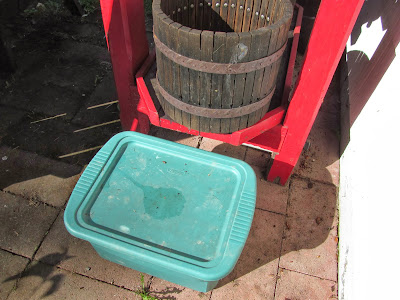 |
| Bubble bubble, no toil, no trouble. |
For years, I've wanted to make hard cider, but never have enough apples at once for it to be worthwhile. I always give the tree's owner a good share, and maybe some to friends and neighbors, but basically the girls and I drink it as fast as we make it. Despite a particularly generous neighbor this year, it was the same story.
Once you press the cider, you end up with a "cheese," the wheel of spent pomace, apples chewed by the mill and crushed dry by the press. In the past, this went onto the worm heap, but this time my inner cheapskate devised another step in the cycle.
I dumped some pomace into a bin, and filled it with water, on the theory that I could coax forth more sugar and get a ferment going that would yield some vinegar. Just a plain plastic bin, sprayed out with a hose, duct tape over two openings that the fruit flies would have entered. Snap on the lid and walk away.
Being shiftless and lazy, I did not keep notes, but fuzzy recollection tells me that fermentation set in quickly, and it was not long until it was frothy. Yeast was gobbling sugar and pumping out alcohol. I shut the lid and walked away for another undetermined amount of time, checking progress intermittently, satisfied that the fermentation gases were escaping, but fruit flies were not getting in.
At some point, the fermentation slowed, and I decided to jettison the fruit. I strained out the liquid and then put the pulp into a canning kettle, pushing it down with the circular wooden plunger from the cider press to squeeze out the last liquid. Then, finally, I let go of the pomace and the fruit flies and worms got their feast on.
This liquid was then covered for the final ferment, turning alcohol into vinegar. Because I'd just let the wild microbes do what they wanted, and maybe also because this was a second pressing, I doubt the liquid was ever really what you would call hard cider. The vinegar smell was present early on, as the Acetobacteria drank alcohol and pissed vinegar. By this time, I had not only apple, but also pear and plum batches a-brewing.
The pear juice was thick and viscous, a syrupy consistency that I hoped translated to sugar. There was more than half a bin of this as I snapped the lid shut and walked away. The times between lifting the lid and checking grew longer, and between stirring even longer. There were some more bubbles, but not as many, as fermentation mellowed and aging began. Meanwhile, the bin sat just under the eaves of the house, getting afternoon sun when it shone, getting cold at night, pretty much neglected. The whole process, I figured, was a very low-stakes gamble. Rather than invest time and effort, what would happen if I let nature take it's course?
Good things, it turns out. A little more than two months after putting the batches in dark places to do their thing, I pulled the bacterial mat off the surface to reveal liquid that was less cloudy than before and much less viscous. It smelled like vinegar, and tasted like it.
Now, I have a quart of plum vinegar, which seems really fine, but I am continuing to age in the fridge. There's a gallon or so of apple, which seems to be fairly weak and clear; I have not tasted it yet, but even if it's not flavorific, I can use it for the 1001 non-food functions of acetic acid. Finally, I have several gallons of pear vinegar, which is pretty good. I pasteurized some (150 degrees for 35 minutes) and bottled it in re-used beer bottles that I boiled for 10 minutes. I just used the regular crown caps like beer, but will seal it with wax if I get around to it. It will be interesting to see how these age. The live stuff is in a big jug out in the garage and a few half-gallon growlers (again, thank you, beer containers) in the fridge.
Already, some of the vinegar has been put to use. Some went to scrubbing down a moldy molding (acetic acid kills mold without killing me), and some went into salad dressing that adorned the last lettuce of the year. Next Summer, I should be able to make pickles using my own vinegar. The frugal, off-the-grid, lazy, and independent parts of me rejoice. Wringing vinegar from spent cider-fruit adds another spoke to the re-cycle.

